Physical Address
304 North Cardinal St.
Dorchester Center, MA 02124
Hair is a protein by-product of follicles distributed everywhere on the body surface except the palms, soles, vermilion portion of the lips, glans penis, penile shaft, nail beds, and sides of the fingers and toes. Although hair is of minimal functional benefit to humans, the psychologic effects of disturbances of hair growth are commonly a source of great concern to children, adolescents, and their parents.
In the human fetus, groups of cells appear in the epidermis at about the eighth week of gestation. These differentiate to form the hair follicles, and hair begins to develop between the eighth and twelfth weeks of fetal life. This growth continues throughout fetal development. Although there are indications that some hair is lost during gestation and at the time of birth, the majority of hairs on the newborn are 5 to 6 months old.
Lanugo hairs are fine, soft, unmedullated, and poorly pigmented hairs seen only in fetal and neonatal life, except in the rare hereditary syndrome hypertrichosis lanuginosa. They appear as a fine, dense growth over the entire cutaneous surface of the fetus. Lanugo hair is normally shed in utero in the seventh or eighth month of gestation, but may cover the entire cutaneous surface of the premature newborn infant. Postnatal hair may be divided into vellus and terminal types. Vellus hairs are the fine, lightly pigmented hairs seen on the arms and faces of children. Terminal hairs are the mature, thick, darker hairs on the scalp, eyebrows, eyelashes, and areas of secondary-sexual hair distribution. The number and distribution of individual hair follicles are genetically determined and constant from birth. As the infant’s skin grows, however, the density of hair follicles reduces from 1135 per cm 2 at birth to 615 per cm 2 by adulthood.
The average human scalp contains 100,000 hairs. The average growth rate of terminal hair is approximately 2.5 mm/week (1 cm/month). The hair shaft represents the equivalent of the stratum corneum of skin, with the follicular keratinocytes dictating the characteristics of the shaft. The hair root is characterized by three definable cyclic stages of growth: anagen ( Fig. 7.1 , A ), catagen, and telogen ( Fig. 7.1 , B ; Box 7.1 ). The human hair follicle has a long phase of regular growth (the anagen phase) that lasts 2 to 6 years, with an average of 3 years. The hairs then undergo a period of partial degeneration (the catagen phase), lasting up to 3 weeks, followed by a resting (telogen or club) phase. The telogen phase of the follicle lasts for about 3 months. At the end of this time, new growth is initiated. As new hairs grow, they push out the old telogen hairs that have remained in the resting follicles. In healthy individuals, 85% to 90% of the scalp is in the actively growing anagen stage and 1% is in the brief transitional (catagen) stage; 10% to 15% is in the resting or telogen stage, with an average of 50 to 100 hairs shed and simultaneously replaced each day. Although scalp hair has a long anagen phase, eyelash and extremity hair have a lower anagen/telogen ratio and thus tend to be shorter.
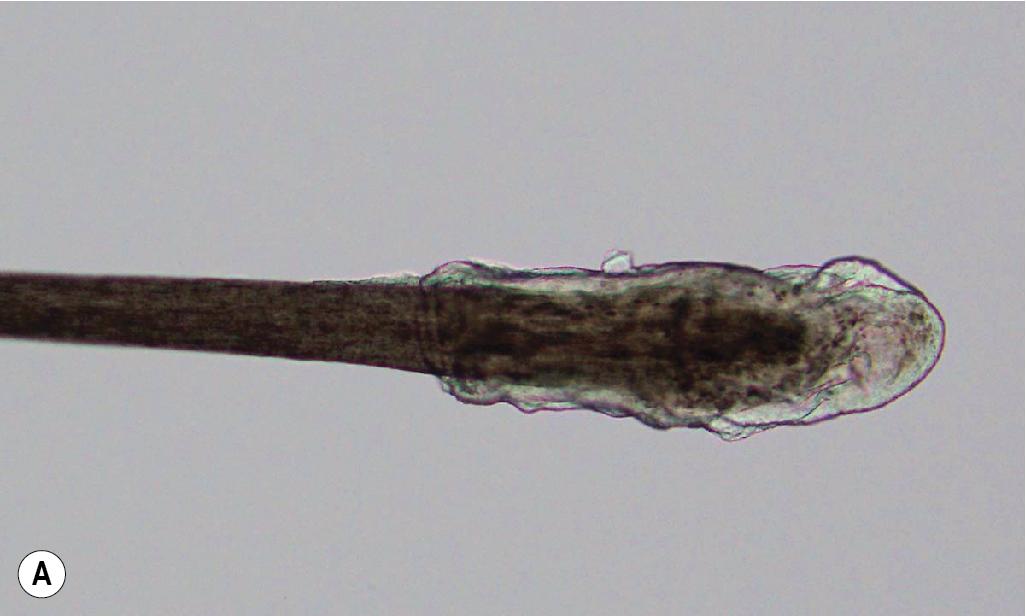
Anagen phase (active growth phase) lasts 2 to 6 years (average 3 years)
Catagen phase (stage of partial degeneration) lasts 10 to 14 days
Telogen phase (resting stage) lasts 3 to 4 months
The first crop of terminal scalp hair is in the actively growing anagen phase at birth, but within the first few days of life there is a physiologic conversion to the telogen phase. Consequently, a high proportion of neonatal scalp hairs are shed during the first 4 months of life ( Fig. 7.2 ). This telogen shedding (telogen effluvium of the newborn) usually is gradual hair loss, particularly between 2 and 4 months and most noticeable at the occipital area. Rarely the hair loss occurs in the first 4 weeks of life in a frontal-temporal pattern. This physiologic hair shedding at the occipital area is not related to the baby’s sleeping position (i.e., friction). Replacement of the first terminal hairs is generally completed before the first 6 months of life. The neonatal hairline commonly extends along the forehead and temples to the lateral margin of the eyebrows. These terminal hairs gradually convert to vellus hairs during the first year of life. Premature infants are often covered by lanugo hairs, which are more densely distributed on the face, limbs, and trunk. This retention of lanugo hair is probably related to the cyclic activity in utero and the normal shedding of telogen vellus hairs in the fetus during the last few weeks of gestation.
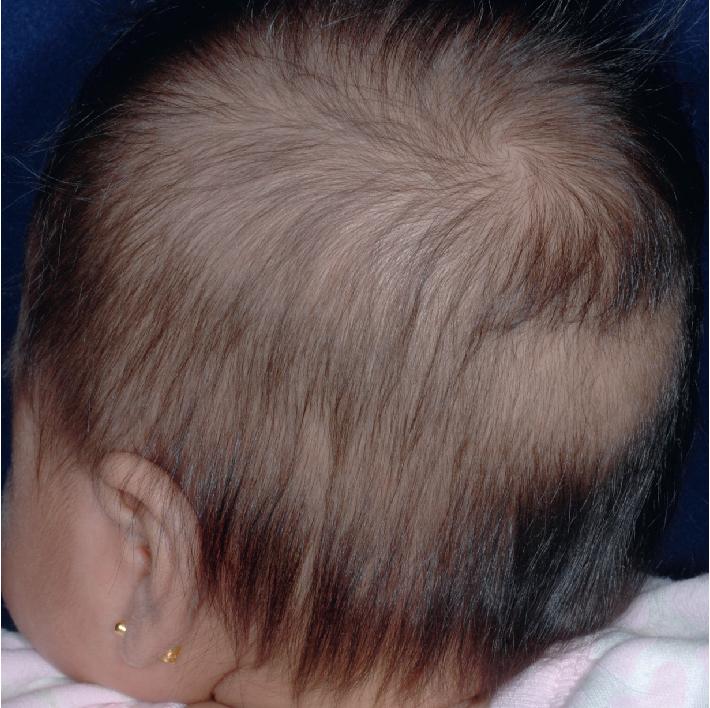
Evaluation of hair disorders starts with taking a good history and performing a careful physical examination, including of the hair and the entire scalp. Careful attention must be paid to the timing of the hair loss, whether there is shedding, whether any contacts have hair loss, recent illness and exposures, medication history, nutrition, and signs or symptoms of other illness, such as thyroid or other autoimmune disease. Examination of the scalp should be focused on determining if the hair loss is nonscarring vs. scarring, hair characteristics, and if there is any patterning ( Box 7.2 ). Several tools are available to help with differentiation among possible diagnoses , ( Box 7.3 ). The hair tug test involves holding the hair between the index finger and the thumb near the root and tugging with the other hand at the distal part; if the hair fractures, fragility is suggested. The hair pull test, in contrast, involves gently pulling at a batch of hairs between the index finger and the thumb. The test is performed at multiple locations on the scalp and is positive if more than 10% of hairs are released. In general, telogen hairs are released, and their identity can be visualized by light microscopy or trichoscopy; however, the hair pull test is positive for alopecia areata (AA), with microscopic evidence of the typical tapered hairs. Trichoscopy is a technique that often allows direct visualization of hairs, rather than pulling of hairs for microscopic evaluation. Loss of follicular ostia identified scarring or cicatricial alopecia, whereas preserved ostia assures of a nonscarring process. One can also visualize scalp erythema, dyspigmentation, pustules, and edema more easily through trichoscopy. Yellow and black dots, as well as exclamation point hairs, are typical of AA. In contrast, comma-shaped hairs and corkscrew hairs are features of tinea capitis. Hair shaft disorders can also be visualized by dermoscopy; one can see uniform elliptical nodes and constrictions (monilethrix), shaft telescoping (trichorrhexis invaginata), twists along the long axis (pili torti), alternating light and dark areas (pili anulati), waves at short intervals (woolly hair), splitting into fibers (trichorrhexis nodosa), or, using polarized light, alternating light and dark bands (trichothiodystrophy).
Overall characteristics: pattern of loss, extent, color, texture, length, breakage
Scalp features: scarring vs. nonscarring, inflammation, trichoscopy (follicular openings), pigmentary change, scaling, crusts, pustules
Hair beyond scalp: eyebrows, lashes, extremity hair, secondary sexual hair if adolescent
Special tests: trichoscopy of shaft, hair pull, hair tug, hair mount (see Box 7.3 )
Hair pull : Grasp about 50 hairs between first three fingers and pull gently but firmly away from scalp at four scalp regions (i.e., frontal, occipital, temporal bilaterally); positive pull test means more than 10% of hairs pull out easily (are in telogen) and is seen with active alopecia areata.
Hair tug : Hold a group of hairs with one hand and use other hand to pull away at distal end, looking for hair breakage (which can then be analyzed microscopically in a hair mount). This can be helpful with fragile hair syndromes such as monilethrix.
Hair mount : Hairs are separated, oriented side by side on a glass slide, covered with mounting medium (such as Permount), and covered with a coverslip without air bubbles. This technique allows one to distinguish anagen from telogen bulbs based on shape and pigmentation, distorted bulbs and cuticles (as in loose anagen syndrome), and hair shaft abnormalities.
Trichoscopy : Can replace hair mounts and microscopy when examining shaft. Disease-specific findings such as for alopecia areata (follicular openings showing yellow dots; “exclamation-point” hairs), tinea capitis (comma or corkscrew hairs), and trichotillomania (coiled or flame hairs); black dots at follicular opening suggest broken hairs and can be seen with alopecia areata, tinea, and trichotillomania.
Clinical examination allows hair loss disorders to be divided into nonscarring (noncicatricial) or scarring (cicatricial) types (see Box 7.2 ). Causes of nonscarring alopecia include alteration of the hair growth cycle, inflammatory cutaneous disease, and structural abnormalities of the hair. , Some traumatic disorders, such as traction alopecia, pressure alopecia, or trichotillomania, can scar if severe but often resolve without clinical evidence of scarring. Evaluation typically involves gentle traction on the hair (hair-pull test) to determine if hair comes out easily (as in loose anagen syndrome [LAS], AA, or telogen effluvium) and microscopic or trichoscopic evaluation of hair shafts to seek hair shaft abnormalities (see Box 7.3 ).
Variations in the structure of the hair shaft are a common occurrence and at times may provide clues to other pathologic abnormalities , ( Box 7.4 ). Because each hair shaft anomaly has a distinctive morphology, the diagnosis often can be established in the office by trichoscopy (using a dermatoscope) (see Box 7.3 ) or by microscopic examination of snipped hairs. Other than reduction of trauma to reduce breakage, there is no effective treatment for this group of disorders.
Trauma (most common)
Argininosuccinic aciduria
Citrullinemia
Oculodentodigital dysplasia
Trichothiodystrophy
Trichohepatoenteric syndrome
Hair keratin mutations (KRT81, KRT83, KRT86)
Desmoglein 4 mutations
Netherton syndrome
Menkes syndrome
Crandall syndrome
Björnstad syndrome
Bazek–Dupré–Christol syndrome
Rombo syndrome
Hypotrichosis with juvenile macular degeneration
Mitochondrial enzyme defects
Group I: mutations in XPD, XPB, p8
Group II: mutations in TTDN1
Group III: Pollitt syndrome, Sabinas syndrome (genes unknown)
Trichorrhexis nodosa, the most common hair shaft anomaly, is a distinctive disorder manifested by increased fragility. , Grayish-white nodules may be seen on the hair ( Fig. 7.3 ), which under trichoscopy or light microscopy have the appearance of two interlocking brushes or brooms, the result of segmental longitudinal splitting of fibers without complete fracture. The disorder features dry, lusterless, short hair that is easily fractured.
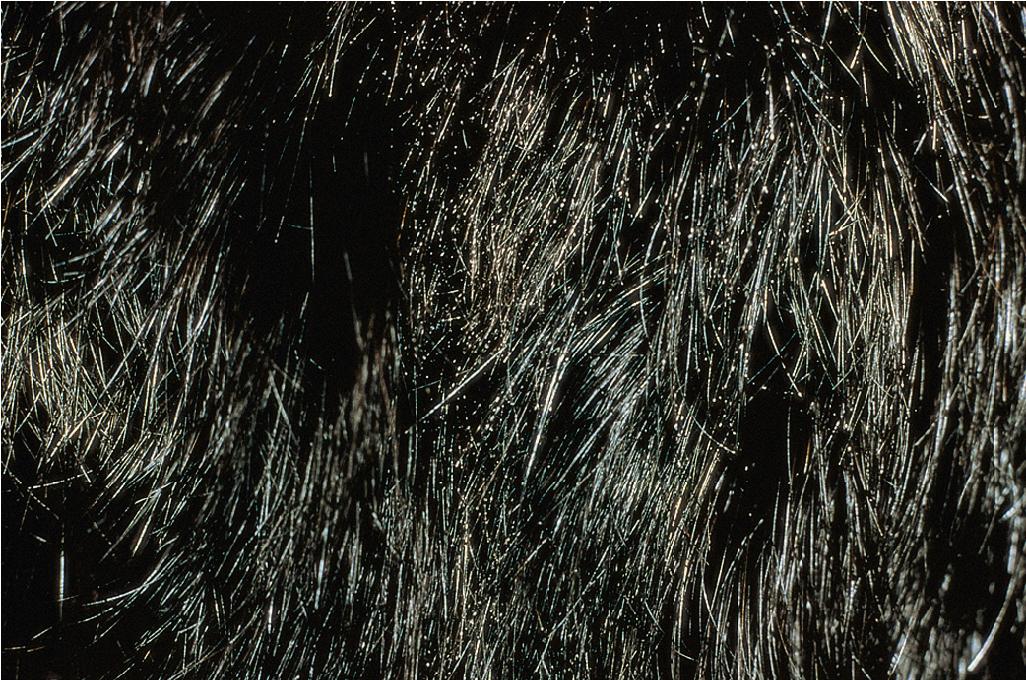
Usually “acquired” in adolescents without other issues, trichorrhexis nodosa most commonly results from trauma to the hair. The injury may result from the use of hot combs, excessively hot hairdryers, hair straighteners, and other chemical treatments or the cumulative cuticular damage from vigorous combing and brushing, repeated salt-water bathing, prolonged sun exposure, and frequent shampooing. Cream rinses and protein conditioners are helpful. If hair-straightening procedures, vigorous grooming habits, and thermal and chemical trauma to the hair are discontinued, the acquired form of trichorrhexis nodosa generally improves within 2 to 4 years.
Less commonly trichorrhexis nodosa is genetic and manifests during infancy. Infants with the autosomal dominant form show normal hair at birth, but the hair that regrows within a few months is abnormal; the hair defect tends to improve with advancing age. Trichorrhexis nodosa may also be a manifestation of children with the late-onset form of argininosuccinic aciduria, a condition that results from lack of argininosuccinase. In this condition, the hair is usually normal at birth and first becomes fragile at 1 to 2 years of age with a dull, matted appearance, especially at the occipital area. The hair defects are associated with psychomotor retardation, cerebellar ataxia, and a marked increase of argininosuccinic acid in the blood, urine, and cerebrospinal fluid. , Dietary treatment of the metabolic abnormality leads to normalization of the appearance and integrity of the hair. Similar clinical manifestations are found in infants with citrullinemia, caused by a deficiency of argininosuccinic acid synthetase. Trichorrhexis nodosa is the most common hair shaft abnormality, but pili torti has been described and hair bulbs may be atrophic. Some patients show an eruption that resembles acrodermatitis enteropathica. Trichorrhexis nodosa has also been described in oculodentodigital dysplasia, , trichothiodystrophy (TTD), and trichohepatoenteric syndrome, characterized by facial dysmorphism, liver disease, immune defects, and severe diarrhea requiring intravenous nutrition.
Monilethrix (beaded hair) is an autosomal dominant disorder characterized by partial alopecia from breakage and variation in hair shaft thickness with small node-like deformities that produce a beaded appearance and internodal fragility. The nodal pattern can be seen by trichoscopy ( Fig. 7.4 ) but can be subtle. , In individuals with this disorder, normal neonatal lanugo hairs are shed during the first few weeks of life. The regrown hair, which generally appears at about the second month of life, is dry, lusterless, and brittle and fails to grow to any appreciable length because of breakage ( Fig. 7.5 , A ). In severe cases, the infant may remain bald or the scalp hair may be sparse, easily fractured, and stubble-like with follicular prominence from keratosis. Although generally a disorder of scalp hair, body hairs may also be affected. The clinical findings are limited to the occiput and nape in more limited cases ( Fig. 7.5 , B ). Occasionally this disorder is not apparent during infancy but becomes apparent later in childhood or during adult life. Follicular keratosis is associated in some pedigrees and may affect the face, scalp, and extremities. Some patients show koilonychia. Spontaneous improvement or remission may occur at puberty or during pregnancy, suggesting a hormonal influence, but the condition may persist unchanged throughout adulthood. Administration of oral retinoids, topical minoxidil, and low-dose oral minoxidil have been reported to improve the alopecia.
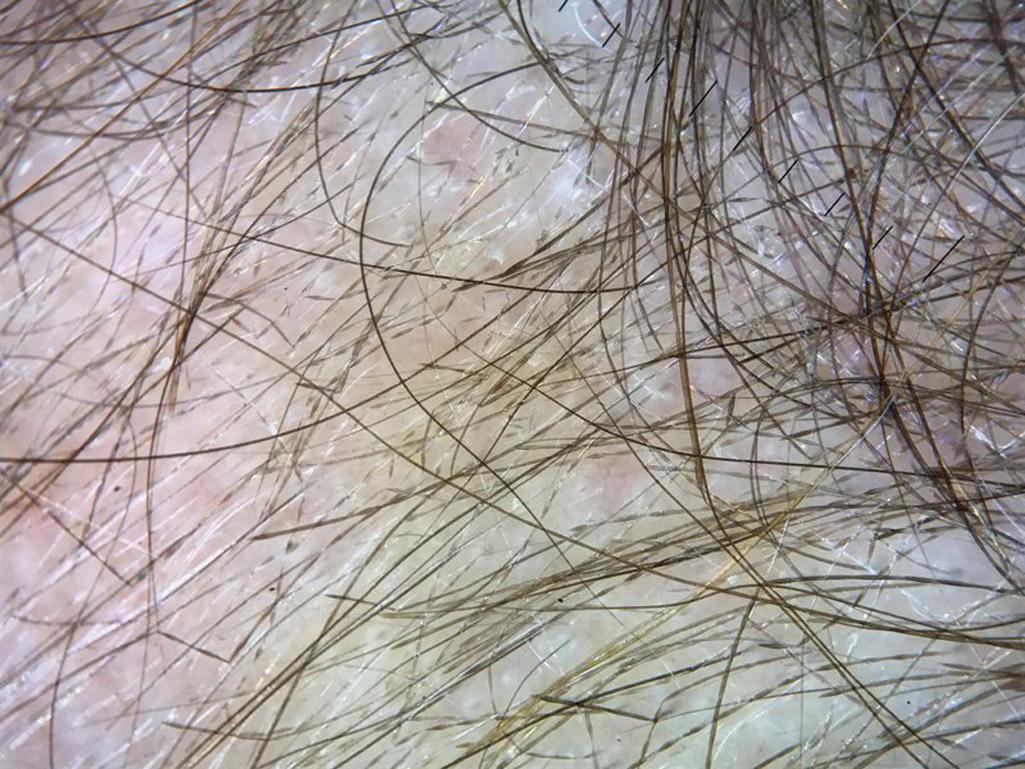
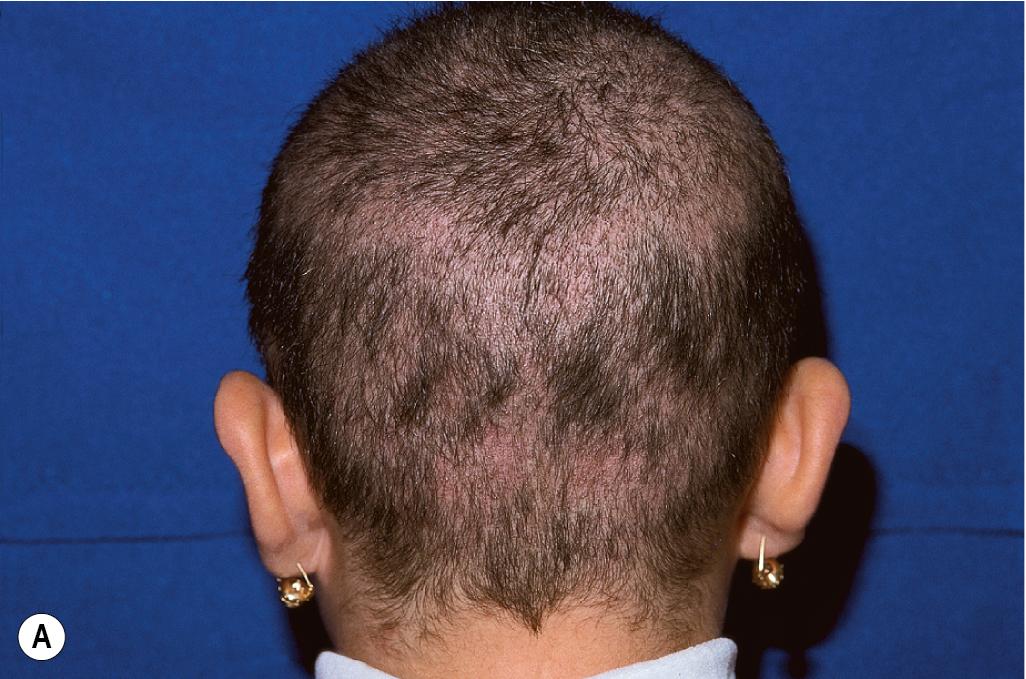
Monilethrix most commonly is autosomal dominant and results from mutations in hair (or trichocyte) keratins. These hair keratins have a high cysteine content, making them “hard” keratins with a high degree of crosslinking. Of the 26 known hair follicle–specific keratins, three have been associated with monilethrix and all are type II keratins. Mutations in KRT81 and KRT86 are most common. Mutations in KRT83 also lead to monilethrix, , but homozygous deletion variants in KRT83 result in generalized ichthyosis with palmoplantar keratoderma and no hair defects. Because keratins provide structural integrity to hair, abnormalities in these keratins lead to hair fragility, with breakage occurring at the internodal sites. Mutations in hair keratins have also been linked to pure hair and nail ectodermal dysplasia (PHNED) ( KRT85 ), woolly hair with hypotrichosis ( KRT71 and KRT74 ), and pseudofolliculitis barbae ( KRT75 ). The majority of the hair keratins remain unlinked to human phenotypes but may impart variants in hair strength, texture, or curliness.
Autosomal recessive monilethrix has been linked to mutations in DSG4 , which encodes desmoglein 4, a transmembranous cell-adhesion molecule of the cadherin family that is predominantly expressed in the hair cortex and upper cuticle. Desmoglein 4 is thought to integrate keratin filaments into desmosomes. Desmoglein 4 mutations may also manifest as autosomal recessive hypotrichosis, which resembles monilethrix but lacks the characteristic beaded appearance of the hair shaft under light microscopy.
Pseudomonilethrix was originally described as an autosomal dominant developmental defect of fragile hair with irregularly shaped nodes. , In fact, the hair changes are artifactual and related to overlapping hairs under the pressure of an overlying glass slide. Pseudomonilethrix is seen more commonly when fine hairs are handled by forceps.
Trichorrhexis invaginata (bamboo hair) is characterized clinically by dry, lusterless, easily fractured, sparse, and short hair. Under light microscopy, the hairs show a peculiar intussusception or telescope-like invagination along the hair shaft, which microscopically resembles the ball-and-cup joints of bamboo. , Variations in trichorrhexis invaginata occur, most commonly “golf-tee hair,” presenting the expanded proximal end of an invaginate node, which is easily seen by trichoscopy. The hair defect in trichorrhexis invaginata is thought to be abnormal keratinization of the hair shaft, which results in softening of the hair cortex and promotes intussusception of the distal portion of the hair shaft into the softer proximal portion.
Although trichorrhexis invaginata may occur as an isolated finding, this hair shaft abnormality is characteristic of Netherton syndrome (see Fig. 7.6 ), an autosomal recessive genodermatosis that has been linked to mutations in SPINK5 (see Chapter 5 ). Neonates with this disorder characteristically show generalized exfoliative erythroderma and failure to thrive, often associated with hypernatremic dehydration, recurrent infections, and sepsis. Severely affected neonates may show extremely sparse and even absent hair, making the diagnosis based on hair shaft examination difficult. However, the eyebrows are almost always short and broken ( Fig. 7.6 , A and 5.35 ); eyebrow hairs should be examined in cases in which the abnormality cannot be demonstrated from scalp hair, and trichoscopy (dermoscopy) can be helpful. ,
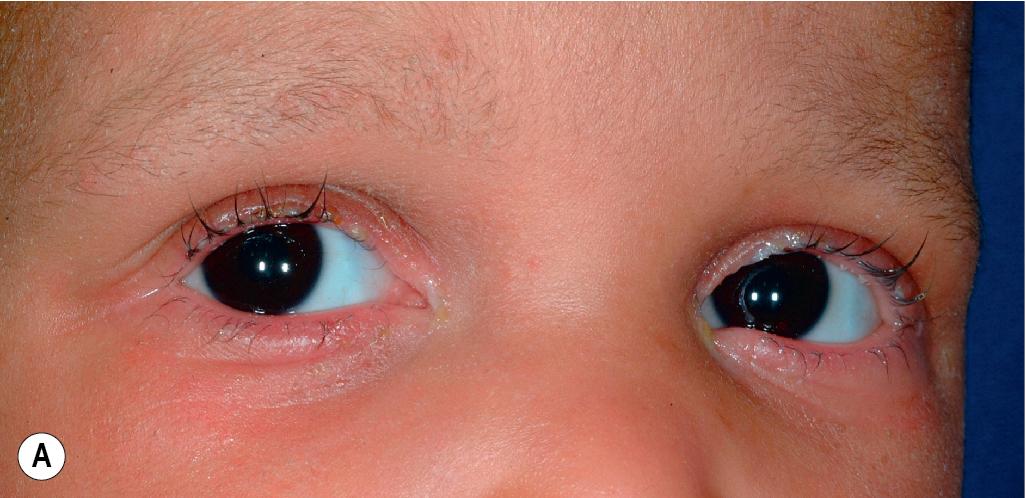
Beyond infancy, many affected individuals show the characteristic skin finding of ichthyosis linearis circumflexa, with walls of scale surrounding red patches, in addition to their dry, lusterless hair that breaks easily (see Fig. 7.6 , B and Fig. 5.34 A ). Atopic conditions usually accompany the ichthyosis. Although spontaneous remission of the hair defect has been described (generally between 6 and 15 years of age), the vast majority show persistence.
Pili torti hairs show three or four regularly spaced twists that occur at irregular intervals along the hair shaft. , The hair shaft appears flattened at the site of the twist, which is almost always through 180 degrees. The dry, fragile hair is often lighter in color than expected and shimmers in reflected light with a “spangled” appearance because of the hair twisting. The hair tends to be short, especially in areas subject to trauma, and may extend out from the scalp. Pili torti must be distinguished from twisted hair, which has been described in association with anorexia nervosa.
Pili torti may occur as an isolated phenomenon with onset at birth or early infancy. This genetic disorder shows both autosomal dominant and autosomal recessive inheritance patterns. The appearance of the hair in patients with pili torti may become more normal with time, although twisted hairs can still be found in the adult scalp; those who still manifest the disorder at puberty, however, are unlikely to show significant improvement with age. A late-onset autosomal dominant form has also been described, in which brittle hair and patchy alopecia develop after puberty. Mental retardation has been noted in some pedigrees. Pili torti has been associated with several mitochondrial disorders (see Pili Torti section).
Menkes syndrome (trichopoliodystrophy) is an X-linked recessive neurodegenerative disorder that affects male infants. Classic Menkes syndrome affects 90% to 95% of patients, with a less common mild form associated with long survival and occipital horn syndrome (previously called X-linked cutis laxa or Ehlers–Danlos syndrome type IX) showing largely connective tissue manifestations. Carrier females may exhibit pili torti. Classical Menkes syndrome is characterized by coarse facies; pili torti; temperature instability; seizures; psychomotor retardation; arterial intimal changes; soft, doughy skin that may resemble localized areas of cutis laxa ; joint laxity; low or absent plasma copper and ceruloplasmin levels; growth failure; increased susceptibility to infection; and death, generally by age 3 or 4 years. , Clinical features often include premature birth, hypothermia, and relatively normal development until 2 to 6 months of age, when drowsiness and lethargy are noted, intractable seizures begin, and growth and development cease. Rarely neonates demonstrate erythroderma as an early sign.
Usually the hair is fine, dull, sparse, and poorly pigmented in infancy; it stands on end and looks and feels like steel wool ( Fig. 7.7 ). Additional features include tortuosity of cerebral and other medium-sized arteries; osteoporosis; frequent subdural hematomas; widening of the metaphyses with spurring; and frequent fractures, at times simulating the radiologic findings characteristic of patients with battered child syndrome. Although pili torti is generally a prominent feature of this disorder, other less commonly reported hair abnormalities include monilethrix and trichorrhexis nodosa.
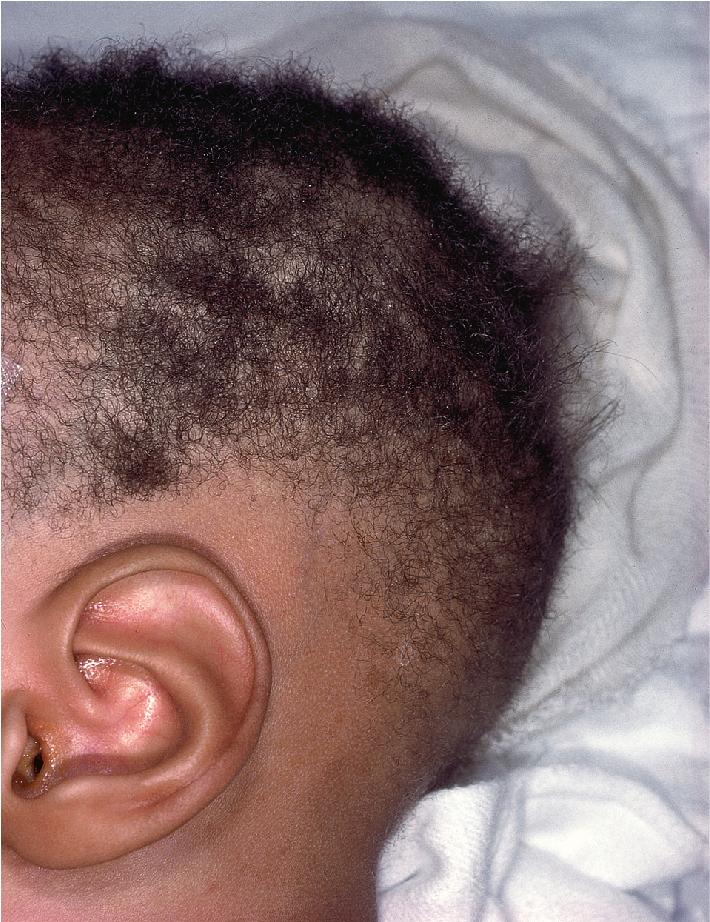
Menkes syndrome results from mutations in ATP7A, which encodes a copper-transporting adenosine triphosphatase (ATPase) that incorporates copper into copper-dependent enzymes and maintains copper levels by removing excessive copper from the cytosol. The combination of clinical features, bone abnormalities, and low plasma copper and ceruloplasmin levels establishes the correct diagnosis. Parenteral administration of copper histidine occasionally prevents neurologic degeneration and pigmentation if initiated in the neonatal or infantile period but often is ineffective.
Crandall syndrome, an X-linked recessive disorder, consists of pili torti with alopecia, sensorineural deafness, and hypopituitarism. Björnstad syndrome is characterized by sensorineural deafness, pili torti, and occasionally mental retardation. The syndrome is autosomal recessive, but families with an autosomal dominant pattern have been described. The recessive form has more recently been linked to mutations in BCS1L, which encodes an ATPase needed to assemble complex III in the mitochondria. More severe defects in BCS1L markedly increase reactive oxygen species and are lethal to neonatal infants with multisystemic involvement (complex II deficiency and growth retardation, aminoaciduria, cholestasis, iron overload, lactic acidosis, and early death [GRACILE] syndrome).
Bazex–Dupré–Christol and Rombo syndromes are X-linked dominant traits characterized by congenital hypotrichosis with pili torti, numerous facial milia, trichoepitheliomas, vellus hair cysts, and an increased risk of the early development of basal cell carcinomas. , Distinguishing features are follicular atrophoderma, hypohidrosis, comedones and facial and neck pigmentation in Bazex–Dupré–Christol syndrome, and atrophoderma vermiculatum and photosensitivity in Rombo syndrome. Females often do not show the hypotrichosis, with normal and pili torti hairs intermingled.
Hypotrichosis with juvenile macular dystrophy (HJMD) is characterized by the development of sparse, short hair from birth or in the first months of life. Fusiform beading and pili torti may be seen by microscopy. Macular degeneration first develops in the first or second decade, leading to blindness by early adulthood. Patients suspected of having HJMD should have annual ophthalmologic evaluations, because early retinal pigmentation and atrophy precede the decrease in visual acuity. The disorder is autosomal recessive and caused by mutations in CDH3, which encodes P-cadherin. , CDH3 mutations also cause ectodermal dysplasia, ectrodactyly, and macular dystrophy ( Table 7.1 ).
| Disorder † | Inheritance | Gene | Protein | Function |
|---|---|---|---|---|
| GROUP 1 | ||||
| EDA/NF-kB Pathway | ||||
| Hypohidrotic ectodermal dysplasia | XLR | EDA1 | Ectodysplasin (EDA) | Membrane ligand |
| Hypohidrotic ectodermal dysplasia | AD | EDAR | EDA receptor (EDAR) | Receptor of EDA |
| EDARADD | EDAR-associated death domain | Adaptor molecule | ||
| Hypohidrotic ectodermal dysplasia | AR | EDAR | EDAR | Receptor of EDA |
| EDARADD | EDAR-associated death domain | Adaptor molecule | ||
| TRAF6 | TNF receptor associated factor 6 | Activates IKK | ||
| Hypohidrotic ectodermal dysplasia with immune deficiency (males) ± osteopetrosis (males) ± lymphedema | XLR | NEMO/ IKBKG | NF-kB essential modulator | NF-kB activation |
| Incontinentia pigmenti (females) | XLD | NEMO/IKK γ | NF-κB essential modulator | NF-κB activation |
| Hypohidrotic ectodermal dysplasia with immune deficiency | AR | IkB α | IkBα | NF-kB activation |
| p63 Pathway | ||||
| Ectrodactyly-ectodermal dysplasia-clefting syndrome | AD | p63 | p63 | Transcription factor |
| Rapp–Hodgkin syndrome | AD | p63 | p63 | Transcription factor |
| Ankyloblepharon-ectodermal dysplasia-clefting syndrome (AEC) | AD | p63 | p63 | Transcription factor |
| Acrodermatoungual-lacrimal-tooth (ADULT) | AD | p63 | p63 | Transcription factor |
| Limb-mammary syndrome | AD | p63 | p63 | Transcription factor |
| C urly h air, a nkyloblepharon, and n ail d ystrophy (CHAND) syndrome | AR | RIPK4 | RIPK4 | Serine/threonine protein kinase |
| Popliteal pterygium syndromes (spectrum) Popliteal pterygium Bartsocas-Papas Cocoon |
AR, AD AR AR |
IRF6 RIPK4 CHUK |
IRF6 RIPK4 CHUK |
Transcription factor Kinase Kinase |
| Ectodermal dysplasia | AD | KDF1 | KDF1 | Keratinocyte differentiation factor |
| Trichodentoosseous syndrome (TDO) | AD | DLX3 | DLX3 | Transcription factor |
| Clefting-ectodermal dysplasia | AR | PVRL1 | Nectin 1 | Interacts with cadherins, esp. at adherens junctions |
| Ectodermal dysplasia-syndactyly syndrome | AR | PVRL4 | Nectin 4 | Interacts with cadherins, especially at adherens junctions |
| Hypotrichosis with juvenile macular dystrophy ± ectrodactyly/ other ectodermal defects | AR | CDH3 | Cadherin 3/ P-cadherin | Adhesion molecule for cell–cell binding |
| WNT Pathway | ||||
| Witkop syndrome | AD | MSX1 | MSX1 | Transcription factor |
| Focal dermal hypoplasia | X-linked dominant | PORCN | PORCN | Regulates Wnt signaling |
| Oculodentodigital dysplasia (ODDD) | AD | WNT10A | Wnt10A | Wnt pathway |
| Hypohidrotic ectodermal dysplasia | AR, AD | WNT10A | Wnt10A | β-catenin-mediated signaling |
| Schöpf–Schulz–Passarge syndrome | AR | WNT10A | Wnt10A | β-catenin-mediated signaling |
| Ectodermal dysplasia | AR | KREMEN1 | KREMEN1 | Receptor involved in Wnt regulation |
| Structural Element | ||||
| Clouston syndrome | AD | GJB6 | Connexin 30 | Intercellular junctions |
| Ectodermal dysplasia | AR | GRHL2 | Grainyhead-like 2 | Transcription factor |
| Oculodentodigital dysplasia (ODDD) | AR | GJA1 | Connexin 43 | Intercellular junctions |
| Ellis van Creveld syndrome | AR | EVC, EVC2 | EVC, EVC2 | Ciliopathy |
| Ectodermal dysplasia 4, hair/nail type (ECTD4) | AR | KRT85 | KRT85 | Keratin |
| Keratitis-ichthyosis-deafness syndrome, autosomal dominant (KID) (see Chapter 5 ) | AR | GJB2 | Connexin 26 | Intercellular junctions |
| Ectodermal dysplasia: skin fragility syndrome (see Chapter 13 ) | AR | PKP1 | Plakophilin 1 | Desmosomal plaque/stability |
| Naegeli- Franceschetti- Jadassohn syndrome (see Chapter 11 ) | AD | KRT14 | KRT14 | Keratin |
| Pachyonychia congenita | AD | KRT 6a, 6b, 6c, 16, 17 | KRT 6a, 6b, 6c, 16, 17 | Keratin |
* Many forms of ectodermal dysplasia remain unclassified.
† Some more recently described forms of ectodermal dysplasia are not yet named.
Individuals with mitochondrial enzyme abnormalities have shown a wide variety of abnormalities, predominantly failure to thrive and neuromuscular changes; however, skin or hair abnormalities have been described in 10% of affected children. Hair abnormalities range from alopecia to dry, thick, brittle hair to hypertrichosis, especially on the back. Syndromic disorders with hair abnormalities may also affect mitochondrial function (e.g., Björnstad syndrome and cartilage–hair hypoplasia). Light-microscopy examination of affected hair has shown a variety of hair shaft defects associated with increased fragility, including pili torti, TTD, trichorrhexis nodosa, and diffuse longitudinal grooving with flattened hair shafts. , Patchy erythematous lesions have been described, and many of the patients with skin manifestations have shown mottled pigmentation.
Pili bifurcati is an uncommon anomaly of hair growth characterized by intermittent bifurcation of the hair shaft in which affected hairs divide into two separate shafts that subsequently become rejoined along the hair shaft. , This bifurcation is repeated at intervals, and the anomaly appears to be transitory, with only a small percentage of hairs exhibiting the bifurcation. This disorder should not be confused with pili multigemini, a disorder in which multiple hairs project from a single hair follicle.
TTD is a heterogeneous group of autosomal recessive disorders in which patients have dry, brittle, cysteine-deficient hair as an isolated finding or in association with often-multisystemic disease. To date, four genes have been linked to autosomal recessive TTD: ERCC2 (XPD) , ERCC3 (XPB) , p8 or GTF2H5 (TTDA) , and C7Orf11/ MPLKIP (TTDN1) . The function of TTDN1 is not well understood, but it likely regulates cell cycling and transcription efficiency. The other three genes encode subunits of transcription/repair factor IIH (TFIIH), a multiprotein complex involved in transcription and nucleotide excision repair. , A recently described form of autosomal recessive TTD results from mutations in GTF2E2, which encodes a subunit of the basal transcription factor II E (TFIIEβ) and is associated with proficient nucleotide excision repair.
Light microscopy of TTD hairs shows a wavy, irregular outline and a flattened shaft that twists like a folded ribbon. Two types of fracture may be seen: trichoschisis (clean transverse fracture) or an atypical trichorrhexis nodosa with only slight splaying of the cortical cells. Trichoscopy using polarized light or polarizing microscopy shows the characteristic alternating light and dark bands, the “tiger-tail” appearance. Although the severity of hair shaft defects is inversely proportional to the hair sulfur content, there is no association between the extent of systemic disease and percentage of abnormal hairs. Sparse hair is often associated with the shaft defect. Some patients have described cyclic hair loss with fever, which may reflect a mutation leading to thermosensitive XPD .
A review of 112 published cases of TTD described the abnormalities beyond hair defects. Ichthyosis has been noted in 65% and clinical evidence of photosensitivity in 24% of these patients. The ichthyosis may resemble autosomal recessive congenital ichthyosis (ARCI) or ichthyosis vulgaris (see Chapter 5 ), and some patients show marked depletion of the granular layer in skin biopsy sections. Of the patients who have TTD with ichthyosis, 37% show a collodion phenotype at birth. Patients may also show xerosis, palmoplantar keratoderma, atopic dermatitis, and/or follicular keratosis. Nail abnormalities have been described in 63% of patients overall, especially dystrophy with thickening or yellow discoloration.
Among the most common noncutaneous features are developmental delay/intellectual impairment (86%), short stature and low weight (73%), and ocular abnormalities (51%, especially cataracts). Facial dysmorphism is seen in 66% of patients, especially microcephaly, large or protruding ears, and micrognathia. An outgoing personality is a characteristic feature. Bone abnormalities are seen radiographically in 38%, particularly osteosclerosis and delayed bone age. Gonadal abnormalities were noted in 14% overall, most commonly hypogonadism and cryptorchidism. Recurrent infections have been noted in 46%, particularly involving the respiratory and gastrointestinal tracts and the inner ear, but were uncommonly associated with immunodeficiency or neutropenia. , Overall, mortality in the first decade of life is increased 20-fold. Not only is there the increased risk of infection, but children with TTD are at high risk for poor outcomes after routine procedures. Complications during pregnancy are noted in 26% of patients, most commonly intrauterine growth retardation, but also preterm delivery; preeclampsia; hemolysis, elevated liver enzymes, and low platelets (HELLP) syndrome; and prematurity. , The newly described form (GTF2E2) is a nonphotosensitive form and is characterized by ichthyosis, failure to thrive, and delayed motor and cognitive development. Unlike xeroderma pigmentosum, TTD is not prone to cancer, although squamous cell carcinoma has been described. ,
Subgroups of TTD have been classified based on clinical characteristics (brittle hair, intellectual impairment, decreased fertility, and short stature [BIDS]; ichthyosis, brittle hair, infertility, developmental delay, short stature [IBIDS]/Tay syndrome; photosensitivity, ichthyosis, brittle hair, infertility, developmental delay, short stature [PIBIDS]). However, a new classification has been proposed that divides patients based on their mutations as group I (mutations in genes encoding subunits of TFIIH: XPD/ERCC2, XPB/ERCC3, TTDA, or p8/GTF2H5 ), II ( TTDN1/MPLKIP and GTF2E2 ), and III (no known molecular basis). Group I includes patients with photosensitivity (either clinical or in vitro ) and is the most common subtype. Most individuals in group II are not photosensitive and show an increased risk of developmental delay, delayed bone age, seizures, and autistic behavior. Currently unclassified but nonphotosensitive patients (such as those with Pollitt and Sabinas syndromes, which have been linked to gene defects) are in group III. Using this classification, ichthyosis and the collodion-baby phenotype are most highly correlated with group I, whereas hypogonadism has been found more in groups II and III.
An X-linked form of nonphotosensitive TTD has been described, characterized by the typical sparse, brittle hair; severe intellectual impairment with microcephaly; and short stature, but also facial dysmorphism and an aged appearance, hypogammaglobulinemia, seizures, endocrine abnormalities, and brain malformations. Ichthyosis and photosensitivity are not features. The disorder results from mutations in RNF113A, which encodes a protein of unknown function.
Marie Unna hypotrichosis is an autosomal dominant disorder manifested by almost complete congenital absence of scalp hair, eyebrows, and eyelashes. The hair regrows to normal density but is coarse, flattened, and twisted. Beginning at puberty the hair becomes progressively sparser, particularly on the vertex and scalp margins, resulting in a high frontal ( Fig. 7.8 ) and nuchal hairline. By adulthood, only a sparse fringe of hair at the scalp margin may remain, and eyelashes, eyebrows, and body hair, including secondary-sexual hair, tend to be sparse. Scattered follicular horny plugs may be associated but no scarring. Trichoscopy/light microscopy of the shaft shows variations in shaft diameter and twisting or bending at odd angles. Other ectodermal structures are unaffected, except that 50% of affected individuals show exceptionally widely spaced upper incisor teeth. Mutations that cause Marie Unna hypotrichosis affect U2HR, an open-reading frame upstream of the hairless gene that inhibits hairless expression; as a result, hairless expression and Wnt signaling are increased. ,
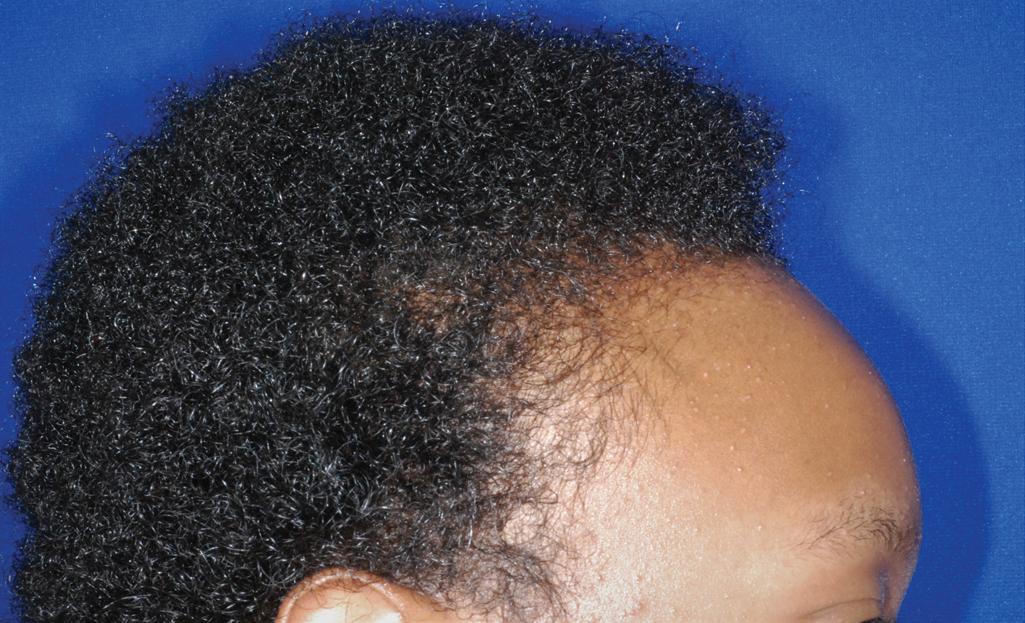
Pili annulati (ringed hair) is an autosomal dominant condition with onset shortly after birth. The hair looks shiny with attractive highlights but has alternating bright and dark bands on close inspection. The bright areas are the result of light scattering from clusters of air-filled cavities within the cortex that appear as dark areas under light microscopy, especially in more proximal hair regions. Pili annulati may increase the risk of developing AA and has been reported to markedly improve or clear after the occurrence of alopecia totalis. The gene mutated in pili annulati has been linked to chromosome 12q24.33, but no mutations in candidate genes have been found.
Pseudopili annulati is an unusual variant of normal hair in which bright bands are seen at intervals along the hair shaft. Secondary to periodic twisting or curling of the hair shaft, this banding is conspicuous only in blond hairs and represents an attractive optical effect caused by reflection and refraction of light by flattened and twisted hair surfaces.
Woolly hair describes a tight, curly hair that is usually present from birth and shows abnormalities under light microscopy. The individual scalp hairs are fine and dry, light-colored, and corrugated at intervals, resembling the wool of sheep. Recognition of woolly hair is important because of the many associated abnormalities. Disorders characterized by generalized woolly hair, keratoderma, and dilated cardiomyopathy have been linked to mutations in indesmosomal proteins (desmoplakin, , plakoglobin, and desmocollin-2 for Naxos disease and Carvajal syndrome; desmoplakin for erythrokeratodermia with cardiomyopathy/EKC, see Chapter 5 ); keratoderma and woolly hair without cardiomyopathy may also result from mutations in KANK2 (see Chapter 5 ). Diffuse woolly hair has also been associated with ocular abnormalities, keratosis pilaris atrophicans, and/or ulerythema ophryogenes, keratosis follicularis spinulosa decalvans (KFSD), giant axonal neuropathy (GAN) syndrome, and primary osteoma cutis.
Woolly hair without associated systemic manifestations can be inherited as either an autosomal dominant or autosomal recessive trait, both of which result from abnormalities of the inner-root sheath of the hair follicles. The entire scalp tends to be affected from birth, but nonscalp hair is normal. The hair grows slowly, is hypopigmented, and shows varying degrees of hypotrichosis. Plucked hair shows a dystrophic bulb and sometimes nonspecific shaft defects. The dominant form results from mutations in KRT25 , KRT71, or KRT74, encoding type 1 hair keratin 25, or its parners, type 2 keratins 71 and 74, respectively.
The recessive forms have now been explained by mutations in two interacting genes, LPAR6 (encoding the lipophosphatidic acid [LPA] receptor 6/ P2RY5 ) , and LIPH (encoding lipase H). , Lipase H reduces phosphatidic acid to LPA, which is involved in lipid and energy metabolism. Biallelic missense mutations in KRT25 have also been reported to cause an autosomal recessive form of woolly hair. , Topical minoxidil has been reported to increase hair thickness and numbers in patients with LIPH deficiency. Woolly (often yellow) hair has also been a feature associated with mutations in PERP, encoding a desmosomal component; the disorder may manifest as an autosomal dominant disorder characterized by palmoplantar keratoderma, cheilitis, and periorificial involvement, resembling Olmsted syndrome, or as an autosomal recessive disorder with more generalized erythrokeratoderma.
The woolly hair nevus is a sporadic condition characterized by the development of one or more patches of hair different in color, shape, and consistency from the normal surrounding scalp hair ( Fig. 7.9 ). The hairs on the affected area are usually smaller in diameter, lighter in color, and sparser than those on the rest of the scalp. When examined under a dissecting microscope, the individual hairs are noted to twist about their long axis. The majority of reported cases of woolly hair nevus have been recognized during the first few months of life, but some have appeared in young adulthood. , In about 50% of cases, woolly hair nevus coexists with a linear epidermal nevus in the same area or elsewhere. , Ocular involvement has been described as an associated feature. Epidermal nevi with woolly hair are linked to mutations in HRAS. , Hairs within the woolly hair patch show follicular miniaturization with increased vellus hairs.
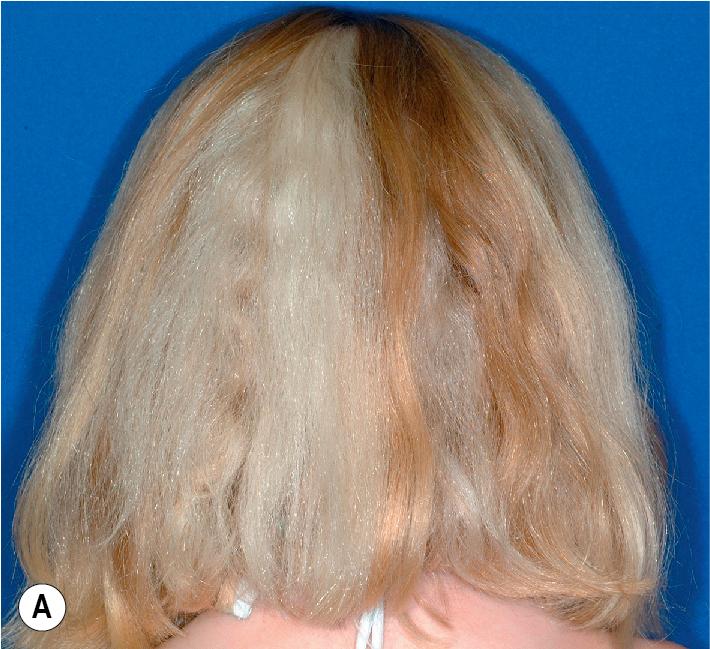
Acquired progressive kinking of the hair is a rare disorder of scalp hair, with onset in adolescence or in young adulthood. The condition is characterized by a rapid onset of extreme curliness of the hair (mainly on the frontoparietal region of the scalp and vertex), often in association with an increased coarse texture, diminished luster, and striking unruliness. The disorder is more common in males than in females. Hair may become darker or remain unaltered in color, and the rate of growth may be decreased or unchanged. Examination of abnormal hairs by light microscopy reveals alterations in hair shaft diameter and partial twisting of the hair on its longitudinal axis.
Although the etiology of this disorder is unknown, it may follow treatment with systemic retinoids, including isotretinoin. The localization of hair kinking, family history of androgenetic alopecia (AGA), pathologic features of the affected scalp, and tendency to evolve into AGA suggest acquired kinking as a harbinger of AGA. No therapy is effective, and application of topical minoxidil has not affected the progressive thinning of hair in the areas of kinking. Spontaneous reversion to normal hair has been reported. Coarse hair, but not woolly hair, is also a feature of Hajdu–Cheney syndrome, resulting from mutations in NOTCH2. Other features include craniofacial abnormalities, short stature, acroosteolysis with broad nails and digits, synophrys, coarse skin, and premature tooth loss with periodontitis.
The uncombable hair syndrome (pili trianguli canaliculi, spun-glass hair syndrome) is a unique hair disorder characterized by very pale, silvery, blond, or straw-colored hair. The hair is dry, frizzy, and unruly, and it does not lie flat on the scalp, thus making combing impossible ( Fig. 7.10 ). , The syndrome is autosomal recessive and results from mutations in one of three genes: PADI3 (encoding peptidylarginine deiminase 3), TGM3 (encoding transglutaminase 3), or TCHH (encoding trichohyalin ). PADI and TGM3 are enzymes responsible for posttranslational modifications in trichohyalin, a hair shaft protein.
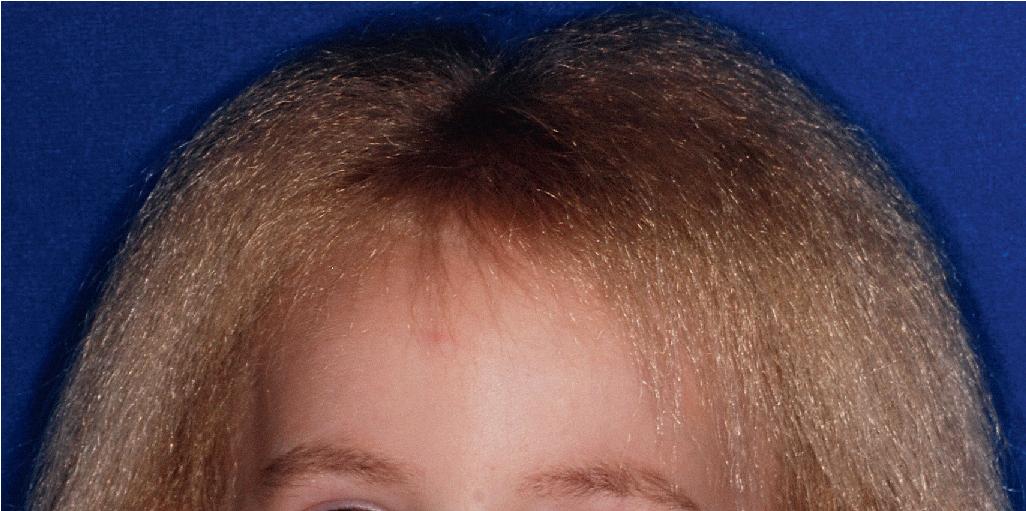
The onset is usually during infancy or early childhood, and eyebrows, lashes, and body hair are normal. Affected children may have minor nail abnormalities, and some show both uncombable hair and loose anagen hair (see Loose Anagen Syndrome section). However, more significant nail abnormalities or other features beyond the hair issue should prompt a search for a second disorder; one child with uncombable hair and congenital anonychia was found to have homozygous mutations in both PADI3 and RSPO4, encoding R-spondin 4 (see nails). The characteristic structural defect of uncombable hair—the presence of canalicular depressions along the hair shaft—can be demonstrated by scanning electron microscopy or by routine microscopy of the hair in cross-section. Cross-sectional microscopy shows a variety of shapes, including triangular, quadrangular, and reniform. The longitudinal grooving and abnormal shape in cross-section, however, are not specific for uncombable hair syndrome and have been described in several other syndromes, among them Marie Unna hypotrichosis, the ectodermal dysplasias with clefting, hypohidrotic ectodermal dysplasia (HED), oral-facial-digital syndrome type I (OFD1), and progeria. The clinical appearance of the spun-glass hair requires a sizable proportion of abnormal hairs, and at least 50% of hairs are abnormal by scanning electron microscopy. The hair tends to become progressively more manageable by adolescence, and some patients have responded to biotin administration.
Uncombable hair syndrome must be distinguished from extremely unruly hair, which is seen in 2% of individuals. Extremely unruly hair that tends to stand up from the area of the posterior parietal whorl toward the frontal hairline may be associated with microcephaly and is a potential indicator of abnormal brain growth and morphogenesis, similar to upsweep of anterior scalp hair and aberrant parietal whorl position.
LAS occurs in 10% of all children who have alopecia and is characterized by actively growing anagen hairs that are loosely anchored and can be easily and painlessly pulled from the scalp. Although considered an autosomal dominant disorder, 70% of cases are sporadic, and in one series, 95% were girls. A mutation in a hair keratin ( KRT75, formerly called K6HF ) has been found in some families, but its relevance is unclear because it does not reliably segregate with the loose anagen phenotype. The mean age of onset in girls is 30 months of age, but of diagnosis is 5 years of age. Most patients are white, and although many patients are blonde, about half of the reported cases have brown hair. Affected children generally have sparse, short, scalp hairs that seldom require cutting ( Fig. 7.11 , A ). Examination shows patchy or subtle diffuse thinning with hairs of uneven length ( Fig. 7.11 , B ). The hair often appears to be limp, and a matted texture with a “bed head” appearance is sometimes noted at the occiput. Of the actively growing anagen hairs, the majority show ruffled cuticles (resembling floppy socks) and pigmented misshapen anagen bulbs (resembling hockey sticks) ( Fig. 7.11 , C and D ). Gentle pulling tends to yield several hairs, allowing the diagnosis to be made by light-microscopic examination of the hair; forceful extraction of hairs may lead to misshaping of normal anagen hairs and thus should be avoided. Shedding of the hair is cyclic, and the inability to extract large amounts of hair by a gentle pull test does not definitively rule out the diagnosis.
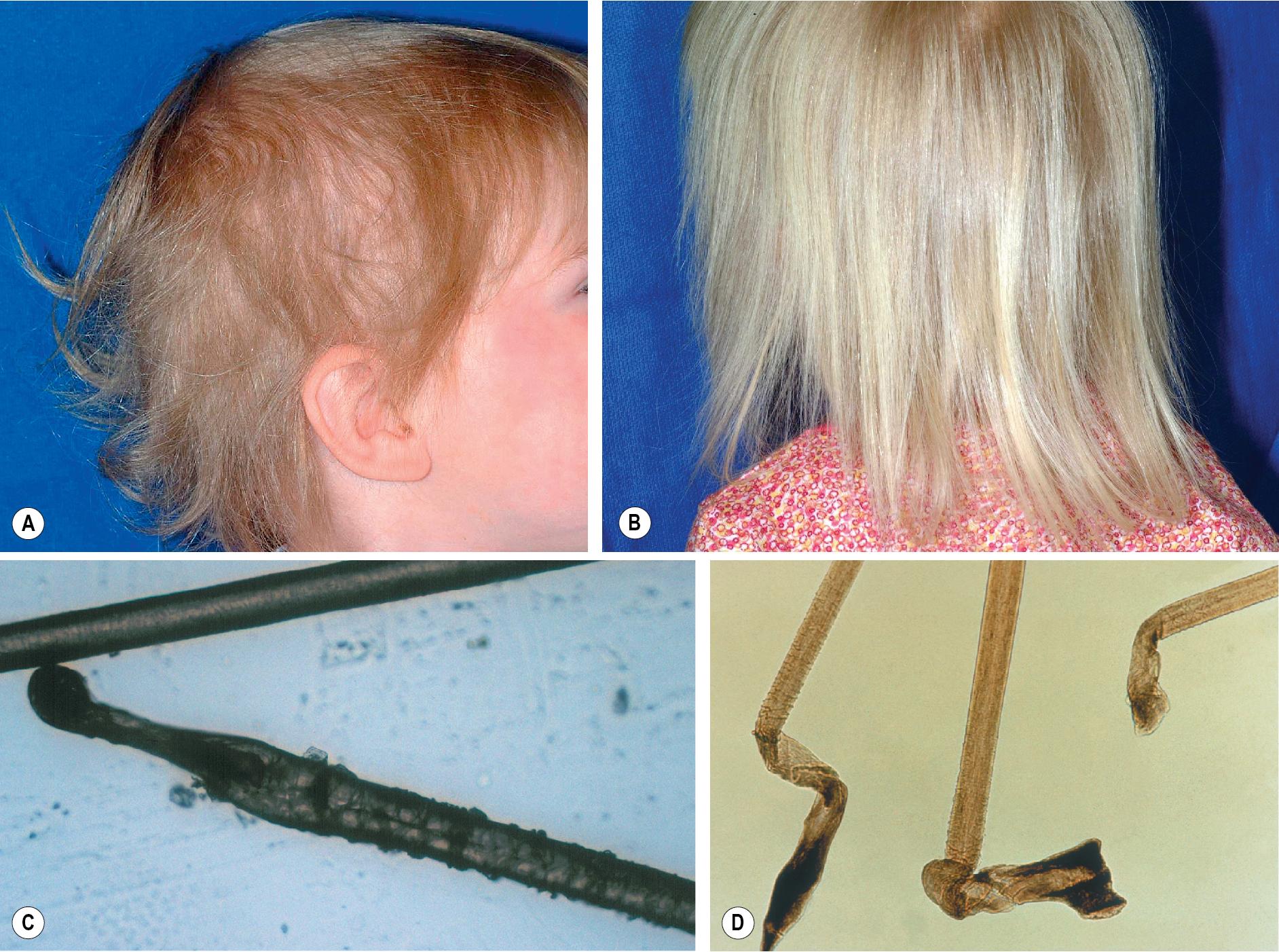
LAS has been classified into three phenotypes. Type A is characterized by sparse hair that cannot grow long. Type B features unruly hair that is diffuse or patchy. Type C has normal-appearing hair, but excessive shedding of the loose anagen hairs. Types A and B almost exclusively affect children. Although no treatment is available for this disorder, it is reassuring for patients and their families to know that other abnormalities are not associated with this disorder, and children with this condition tend to improve with time. Gentle hair care and volumizing shampoos/conditioners have been recommended. There is no good evidence to date that oral biotin administration or application of topical minoxidil is helpful.
Loose anagen hair is also a feature of an autosomal recessive Noonan-like syndrome (Noonan-like syndrome with loose anagen hair) that has been linked to mutations in SHOC2 or PPP1CB, encoding a subunit of protein phosphatase 1, which forms a complex with SHOC2 . In addition to the fine, sparse, unruly hair, affected children show the Noonan syndrome facies and broad neck; macrocephaly; reduced growth with delayed bone age (often from growth hormone deficiency); variable cognitive defects; hyperactivity; hypernasal voice; darkly pigmented, thickened skin with dermatitis; and cardiac defects. LAS has also been described in hypohidrotic ectodermal dysplasia.
Congenital triangular alopecia is characterized by an area of alopecia that, although sometimes notable at birth in babies with abundant scalp hair, is usually detected at 2 or 3 years of age ( Fig. 7.12 ). It is often earlier in boys than girls because of the shorter hair. An initial appearance during adulthood has been described. The area is triangular and overlies the frontotemporal suture, with the base of the triangle directed forward. The triangular patch may extend to the hairline, but often a fringe of hair may separate it from the forehead. Generally measuring 3 to 5 cm from base to apex, the area may be completely bald or partially covered by vellus hairs and remains unchanged throughout life. The differential diagnosis includes AA, trichotillomania, and traction alopecia. Dermoscopy of the affected area shows normal follicular openings with vellus hairs, whereas dermoscopy of AA shows dystrophic and exclamation-point hairs. Although unilateral in 80% to 90% of affected individuals, it may be bilaterally symmetric, and on rare occasions, similar triangular patches may be noted on the temporoparietal area, occipital scalp, or nape.
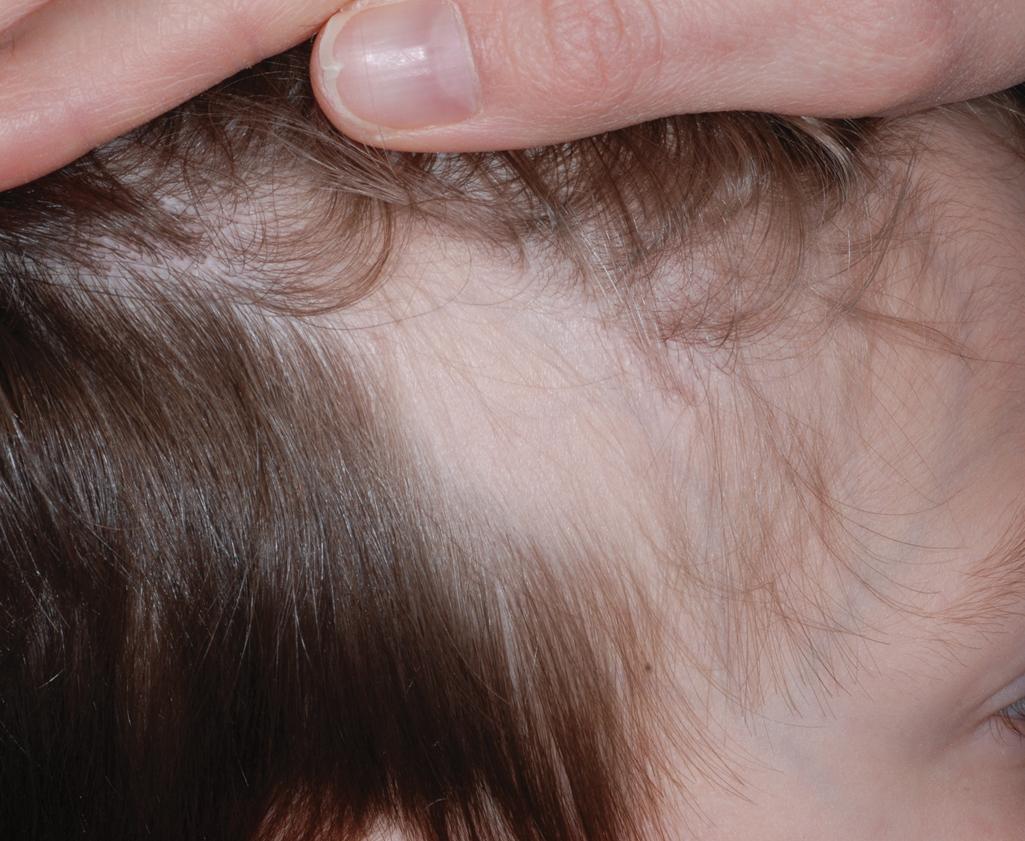
The condition is almost always sporadic, although the association with developmental delay and seizures has been described in a mother and daughter. Congenital triangular alopecia has been described in a patient each with phakomatosis pigmentovascularis, Down syndrome, and Dandy–Walker malformation. Hair transplants have been used to repopulate the area of triangular alopecia. Bilateral congenital localized patches of alopecia of the parietal area that resemble the alopecia of congenital triangular alopecia have been seen in patients with Gomez–Lopez–Hernandez syndrome (cerebellotrigeminal–dermal dysplasia). Although the alopecia classically affects the parietal area, other sites have been reported to show symmetric alopecia. Other features are skull defects (craniosynostosis with brachycephaly, midfacial hypoplasia), neurologic abnormalities, short stature, hypertelorism, and corneal opacities.
Individuals who initially have hair but lose it all, with the first hair shedding shortly after birth, likely have atrichia with papular lesions (APL; resulting from mutations in the hairless gene) or, alternatively, vitamin D–dependent rickets type IIA (caused by mutations in the vitamin D receptor). , Affected individuals never regrow scalp hair and tend to be nearly totally devoid of eyebrows, lashes, and axillary and pubic hair ( Fig. 7.13 ). Follicular cysts and milia-like lesions may appear on the skin later in life (hence the nomenclature of “with papular lesions”). Scalp biopsies show disintegration of the lower two-thirds of the hair follicle, which is often replaced by cysts. Patients with vitamin D–resistant rickets are clinically and histologically identical to patients with APL but show the additional manifestations of early-onset rickets, hypocalcemia, secondary hyperparathyroidism, and elevated 1,25-dihydroxyvitamin D 3 . The similarity in phenotype reflects the direct regulatory effect of the vitamin D receptor and hairless gene on each other via a transcriptional mechanism. , This group of patients is often misdiagnosed as having alopecia universalis, and they must be also be distinguished from patients with PHNED, an autosomal recessive disorder resulting from mutations in KRT85, KRT74, or the HOXC13 homeobox gene, which usually presents with congenital complete alopecia and uniformly small, dystrophic nails. Sometimes, lacrimal duct obstruction and very short, sparse, fragile hair may be present in PHNED and is easily visualized by trichoscopy.
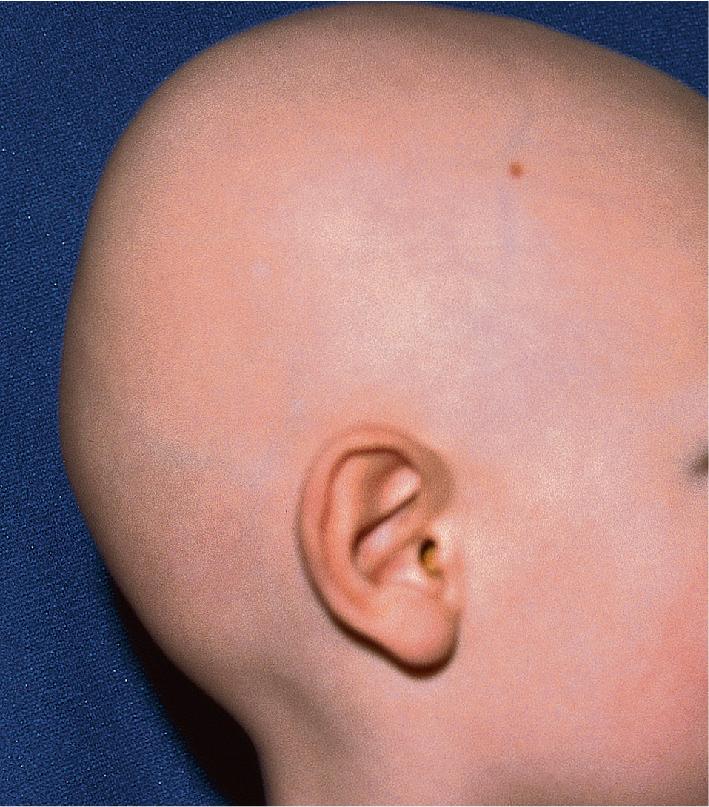
Hypotrichosis simplex is a group of rare autosomal dominant and autosomal recessive nonscarring alopecias in which patients are usually born with normal hair. Hair loss can begin in the first months or even as late as the first decade ( Fig. 7.14 ) and can progress to almost complete loss of scalp hair by adulthood. Graying has been reported to coincide with hair loss. Some individuals show sparse, fine, short hairs, especially at the crown, but hair on sites other than the scalp is normal. The disorder has considerable genetic heterogeneity. Autosomal dominant forms result from mutations in genes encoding corneodesmin, a protein of the corneocyte desmosomes and inner hair sheath (see Peeling Skin Syndrome section, Chapter 5 ) , ; a protein of the pre–messenger ribonucleic acid (mRNA) processing spliceosome (SNRPE) ; and APCDD1, an inhibitor of Wnt pathway signaling. Localized autosomal recessive hypotrichosis most often results from variants in the lipase pathway (see Woolly Hair section). Homozygous variants in the gene encoding C3ORF52, which is co-expressed and interacts with lipase H in the inner root sheath of the hair follicle, reduced lipase H-mediated lipophosphatidic acid biosynthesis and leads to hypotrichosis without woolly hair. Localized autosomal recessive hypotrichosis can also be associated with scalp follicular keratosis, which can be confused with monilethrix.
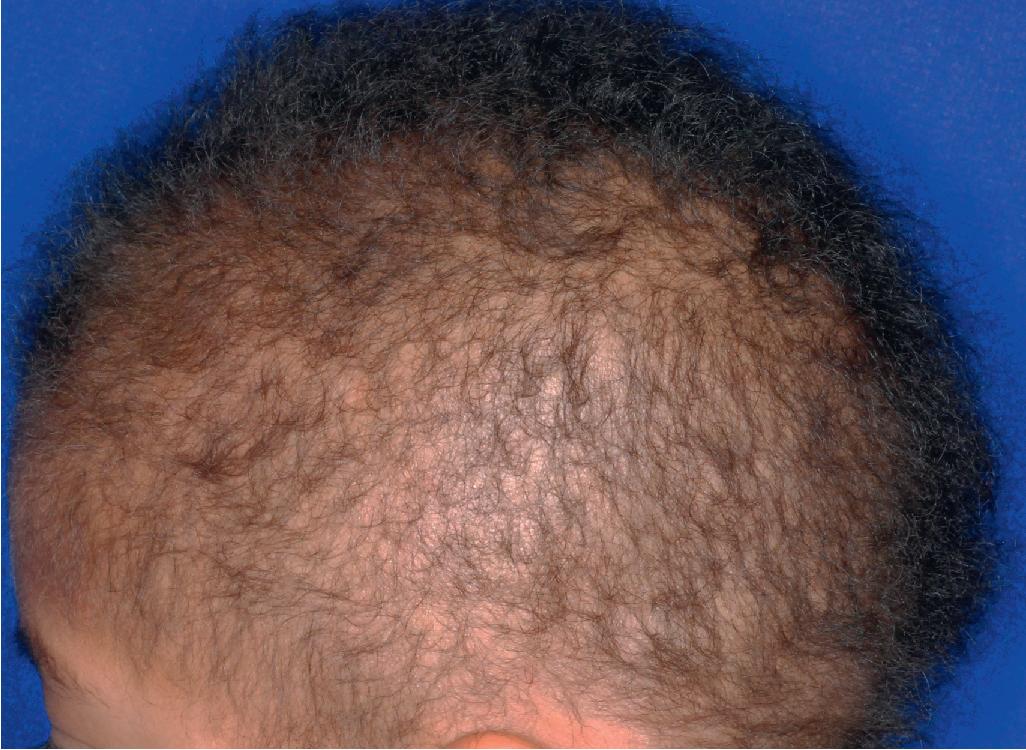
Hallermann–Streiff; Sensenbrenner; Coffin–Siris; Nicolaides-Baraitser; and growth retardation, alopecia, pseudoanodontia, and optic atrophy (GAPO) syndromes all show hypotrichosis in association with facial dysmorphism and other physical signs (see Online only). In Hallermann–Streiff syndrome (oculomandibulodyscephaly), hypotrichosis of the scalp, eyebrows, and eyelids is associated with dwarfism, beaked nose, and brachycephaly. The alopecia is most prominent at the frontal and parietal areas and is especially marked along suture lines. Axillary and pubic hair may also be scant, and cutaneous atrophy, largely limited to the scalp and nose, may appear as thin, taut skin and prominent underlying blood vessels. Other features include frontal and parietal bossing, mandibular hypoplasia, microphthalmia, low-set ears, thin and small lips, high-arched palate, atrophy of the skin of the face, congenital cataracts, blue sclerae, motor and occasionally mental retardation, and dental abnormalities.
Sensenbrenner syndrome, or cranioectodermal dysplasia, is a rare autosomal recessive disorder manifested by small stature, dolichocephaly, an unusual facies, and tubulointerstitial nephritis leading to early end-stage renal failure. The typical facies show frontal bossing, hypertelorism, prominent epicanthal folds, antimongoloid palpebral fissures, eversion of the lip, and full-rounded cheeks. Patients have small, gray, widely spaced teeth; short, fine, hair; and hypohidrosis. Sensenbrenner syndrome is a ciliopathy that results from mutations in IFT122, WDR35, or IFT43.
Patients with Coffin–Siris syndrome most commonly show a constellation of severe mental retardation; a characteristic coarse-appearing facies; scalp hypotrichosis with hypertrichosis of the eyebrows, eyelashes, face, and back; hypotonia; hypoplastic to absent fifth fingernails and distal phalanges; and feeding problems with postnatal growth deficiency. Coffin–Siris syndrome is autosomal dominant and results from mutations in one of several components of the SWItch/sucrose nonfermenting (SWI/SNF; also called BAF ) adenosine triphosphate (ATP)–dependent chromatin-remodeling complex. , Of these, mutations in ARID1B are most common (76% in one series). , A related disorder is Nicolaides–Baraitser syndrome, which results from mutations in SMARCA2, which encodes one of two subunits of this BAF chromatic remodeling complex. Nicolaides–Baraitser syndrome is an autosomal dominant disorder with cardinal features that include intellectual disability of varying extents, short stature, microcephaly, typical facies, and sparse scalp hair in association with brachydactyly, seizures, and behavioral problems.
As mentioned, GAPO is an acronym for growth retardation, alopecia, pseudoanodontia, and optic atrophy . Distinctive craniofacial features include an aged appearance with frontal bossing, high forehead, midfacial hypoplasia, hypertelorism, and thickened eyelids and lips. GAPO syndrome is autosomal recessive and results from mutations in ANTXR1, which encodes anthrax toxin receptor 1. Although the alopecia usually affects the entire scalp and starts shortly after birth, it occasionally starts as late as 2 years of age and can be partial at first (occipital or in a pattern resembling androgenetic alopecia). Eyebrows and lashes are also sparse.
Cartilage–hair hypoplasia syndrome is an autosomal recessive disorder that occurs primarily in inbred Amish or Finnish populations. , Patients have short limbs and sparse, fine scalp and body hair. Several patients with hyperextensible digits and soft, doughy skin, reflecting degenerated elastic tissue, have been described. Defective cell-mediated immunity is seen in most patients and results in relative anergy, altered T-cell responses, and increased susceptibility to severe viral infections, particularly varicella. Patients may have infantile neutropenia, Diamond–Blackfan anemia, severe combined immunodeficiency, celiac syndrome, and/or toxic megacolon. Mild to severe bronchiectasis has been noted in more than 50% of patients. Approximately 10% develop malignancy, especially lymphoreticular; an increased prevalence of early basal cell carcinomas has also been described. The disorder results from mutations in ribonuclease (RNase) MRP, which cleaves RNA in mitochondrial deoxyribonucleic acid (DNA) synthesis and preribosomal RNA in the nucleolus. Alopecia is seen with macrocephaly, cutis laxa, and scoliosis in macrocephaly, alopecia, cutis laxa, and scoliosis (MACS) syndrome (see Chapter 6 ).
Trichorhinophalangeal syndrome (TRPS) type I is an autosomal dominant disorder characterized by a distinctive facies with pear-shaped nose, elongated philtrum, thin upper lip, supernumerary incisors, and receding chin ( Fig. 7.15 ) and skeletal abnormalities, including brachydactyly, deviation of the middle phalanges ( Fig. 7.16 , A ), hip malformation, and short stature. Most patients show fine, sparse, slow-growing hair, but almost-normal hair to complete baldness have been described. The underlying molecular basis is a mutation in TRPS1, which encodes a transcription factor. The diagnosis is made by the demonstration of cone-shaped epiphyses of the fingers seen on plain radiography ( Fig. 7.16 , B ). These findings may not be detectable until 3 years of age or older. The type II form of TRPS (Langer–Giedion syndrome) is a contiguous gene syndrome, with contiguous deletion of TRPS1, RAD21, and EXT1, which gives patients the associated multiple exostoses. These exostoses are typically first seen on the scapulae, elbows, and knees during infancy or preschool years. Type III TRPS results from mutations in TRPS1, but manifests with much more severe short stature and generalized shortening of all phalanges and metacarpals than TRPS type I. Good retention of frontal scalp hair has been shown after transplantation in a patient in whom minoxidil was not helpful.
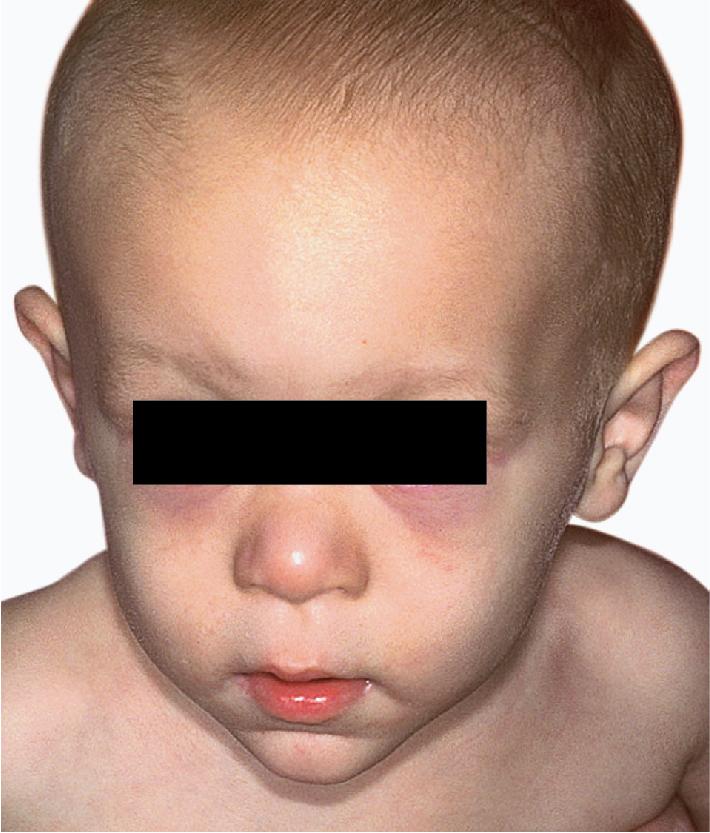
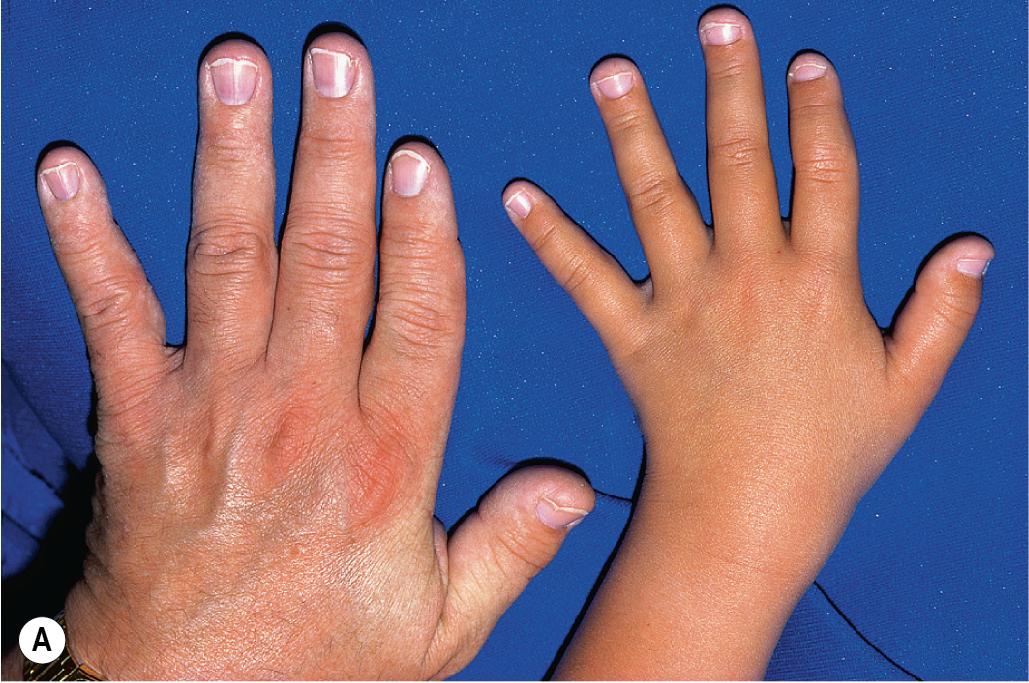
Oral-facial-digital syndrome, type 1 (OFD1) is an X-linked dominant ciliopathy largely limited to girls. Typically, the disorder is thought to be lethal in boys, although surviving boys with in-frame or missense mutations have been described. , The disorder results from mutations in OFD1, which encodes a centrosomal protein of primary cilia. Facial features occur in almost 70% of patients and include hypoplasia of nasal cartilage and hypertelorism with lateral displacement of the inner canthi (dystopia canthorum) ( Fig. 7.17 ). Among the oral anomalies described are tongue hamartomas, lobulated cleft tongue, cleft lip and palate, maldeveloped frenula, asymmetry of the lips and tongue, and maxillary gingival swelling. Associated hand malformations are common and include brachydactyly, syndactyly, clinodactyly, and polydactyly. Almost half of affected individuals show central nervous system (CNS) involvement, most commonly retardation or selective cognitive impairment. Cutaneous abnormalities occur in the minority of patients but include numerous milia at birth and sparse fine or coarse, dry, and lusterless hair to frank alopecia. Polycystic kidney disease with renal insufficiency is occasionally seen in children but more often occurs with advancing age (>50% after age 36 years). Other “ciliopathies” share the CNS, skeletal, and cystic renal abnormalities of OFD1. An autosomal recessive form of OFD syndrome has been described, resulting from homozygous variants of the helicase gene DDX59 . Features include lobulated or bifid tongues with hamartomas, developmental delay with microcephaly, and variable polydactyly.
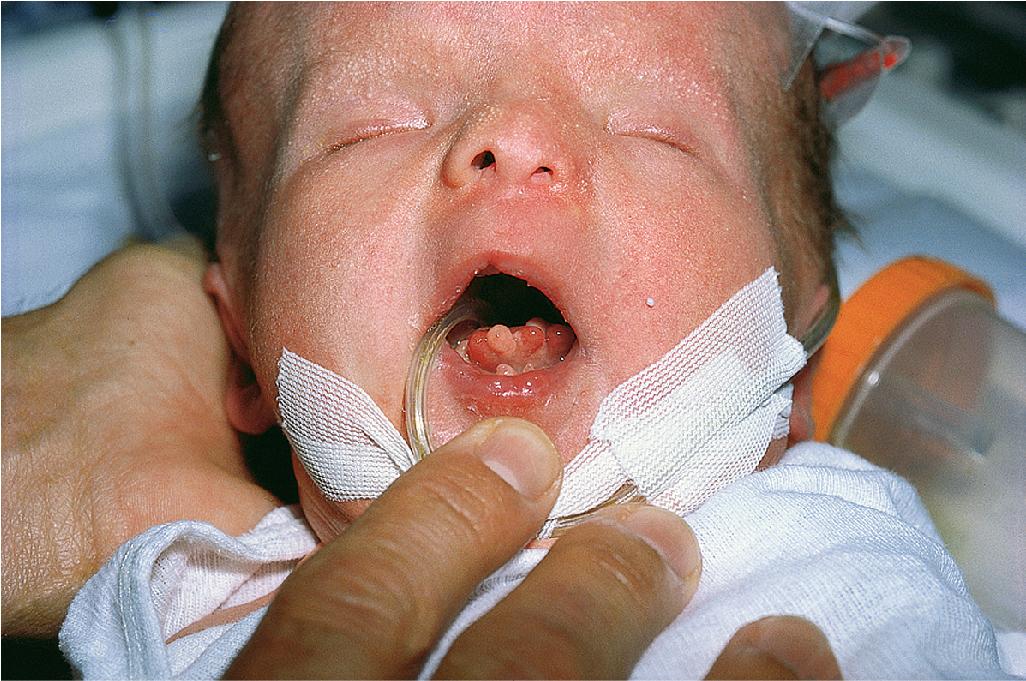
Become a Clinical Tree membership for Full access and enjoy Unlimited articles
If you are a member. Log in here